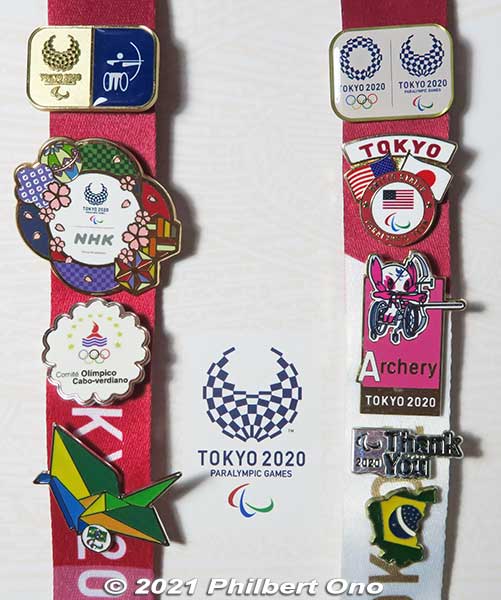Comprehensive chronology of the Tokyo 2020 Paralympics from Aug. to Sept. 2021. No spectators were allowed at competitions. Only team members, coaches, staff, press members, and volunteers were allowed in.
Updated: Nov. 5, 2023
Compiled and written by Philbert Ono (former TOCOG employee). Preserving Tokyo 2020 history, images, and memories.
Tokyo 2020 Paralympics: August 24–September 5, 2021
August 17, 2021: Paralympic Village in Harumi opens.
August 20, 2021: The giant Paralympic Agitos logo (17.5 meters high) on a floating barge is installed at Odaiba Marine Park. Lit up in white in the evenings.

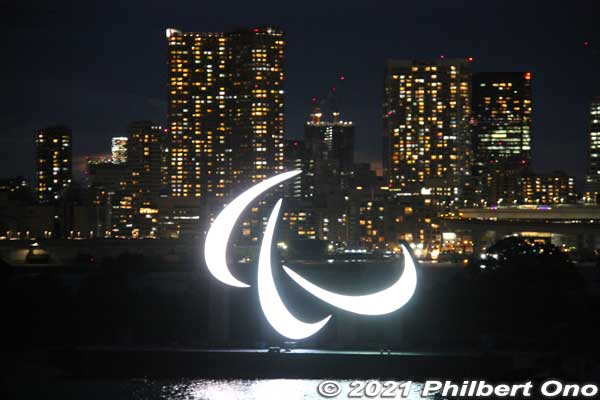
🔴 August 24, 2021: Tokyo 2020 Paralympics Opening Ceremony is held with 3,400 athletes and no spectators at the Olympic Stadium. Average viewership in the Kanto region is 23.8 percent of all households.
🔴 August 24–September 5, 2021: The Tokyo 2020 Paralympics is held with a record 4,403 athletes from 163 NOCs (including a refugee team) competing in 539 events across 22 sports. Japan’s Paralympic team is the biggest ever with over 250 athletes. For gender equality at Tokyo 2020, a record 42 percent of Paralympic athletes are female.
During the Tokyo 2020 Paralympics, new world records are set in 153 events in six Paralympic sports.
The number of Tokyo Paralympics participants from overseas is reduced to one-third the original number, from 36,000 to 10,000 people.
Breakdown:
Paralympic Family: 300
NPC (National Paralympic Committees, including Para athletes): 4,800 (Final count 4,403)
IFs (International sports federations): 800
OBS (Olympic Broadcasting Services): 2,200
Press: 500
Others: 1,200
Approx. total from overseas: 10,000
🍀 Athletes and staff/volunteers working near athletes are tested daily for Covid. Other volunteers and staff are tested at least every four days for Covid with saliva samples.
🍀Total 24,514 Games volunteers work during the Paralympics, including 5,216 volunteers who also worked at the Olympics. Some volunteers assigned to Event Services (EVS) to take care of spectators are reassigned to other roles.
Hot weather persists during the first half of the Paralympics in central Tokyo, followed by cool, rainy days. No typhoons.

During the Paralympics (August 25–September 5), heat illness befell on 34 Para athletes (3 taken by ambulance, no hospitalizations) and 18 staff (1 taken by ambulance).
With normal spectators banned, the Tokyo 2020 Paralympics saw a total of only 15,700 spectators who were all students participating in a government-backed education program in Tokyo, Saitama, and Chiba Prefectures.
August 25, 2021: In Chiba city, six Kaizuka Junior High School teachers take 55 students to see goalball at Makuhari Messe. Two of the teachers later test positive for Covid. Their students are not infected. The news spooks other schools and parents who cancel their school trips to see the Paralympics. Although Chiba city planned to continue the Paralympic spectator program for elementary school children, Chiba Prefecture later withdrew its high school students from the program on August 30.
August 26, 2021: At the Paralympic Village, an e-Palette self-driving vehicle transporting athletes within the village hit a visually-impaired Japanese judoka, Kitazono Aramitsu, who suffered injuries forcing him to withdraw from competition. The collision occurred when the vehicle was already braking to stop for the judoka, but hit him before coming to a complete stop. The e-Palette vehicle operation is suspended until August 31 when an accident investigation is completed and safety measures are reinforced.
August 29, 2021: IOC announces that former IOC President Jacques Rogge passed away at age 79. On September 7, 2013 at the 125th IOC Session in Buenos Aires, it was Rogge who held up the iconic sign announcing “Tokyo” winning the bid to host the 2020 Summer Olympics and Paralympics in a final vote against Istanbul.
Paralympic Flame at Yume-no-Ohashi Bridge
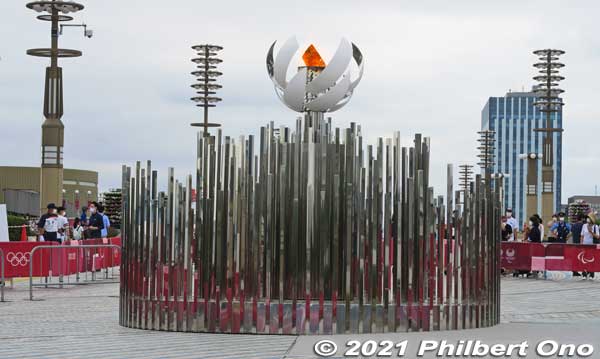
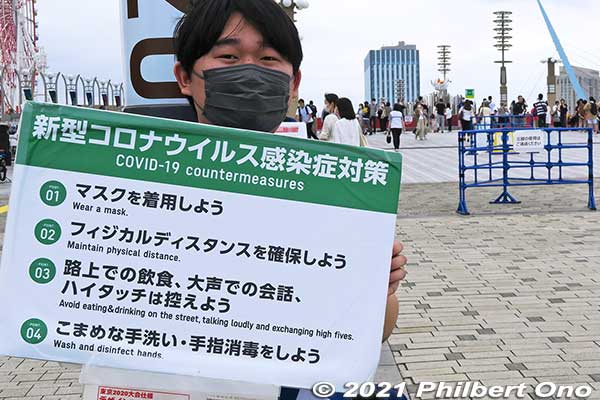
It burns in a smaller version of the cauldron lit in the Olympic Stadium during the Opening Ceremony.
With City Cast volunteers holding signs to remind onlookers to follow Covid safety measures, the Paralympic flame is surrounded by a fence. The first Olympic/Paralympic in Games history to be fueled by hydrogen instead of propane in past Games. Since a hydrogen-burning flame is colorless, sodium carbonate was added to the hydrogen gas to create an orange-yellow flame.
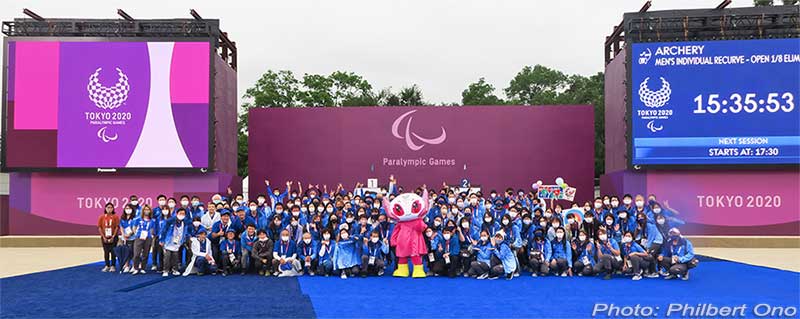
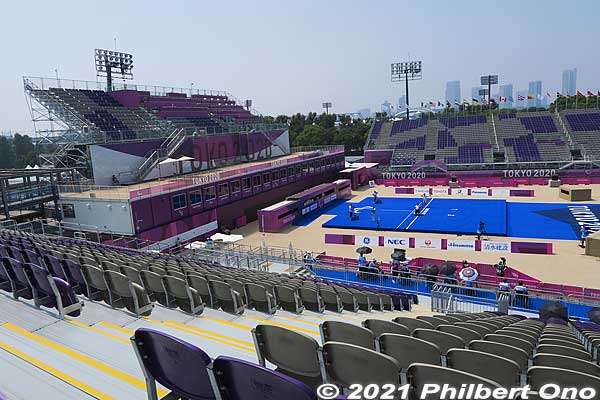
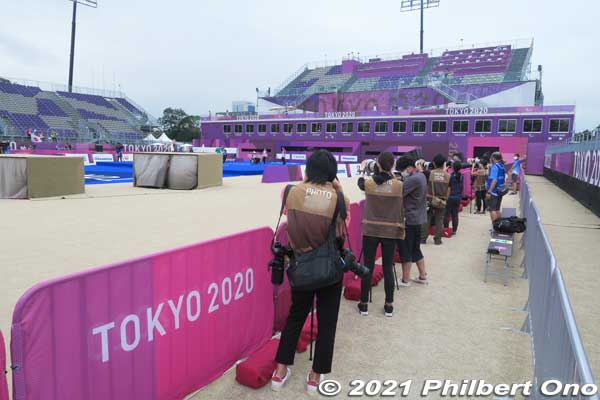
A: Yumenoshima Final Field‘s South Stand on the left, as seen from the East Stand. Athletes competed in front of the South Stand.
B: At the Final Field, Japanese press photographers focus on Japanese archers. They also had the option to use the box-like hides seen on the left.

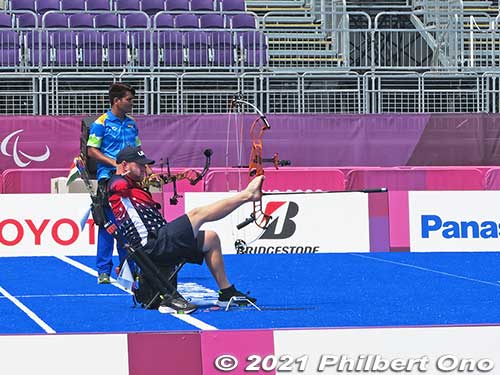
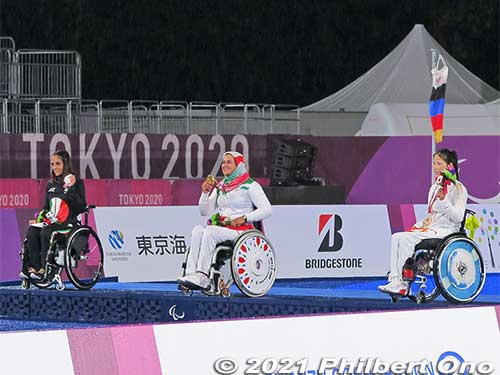
C: Matthew Stutzman aka “Armless Archer” in Men’s Individual Compound – Open 1/16 Elimination on Aug. 28, 2021.
D: Women’s Individual Recurve – Open medalists on the Victory Ceremony medals podium.
L-R: Silver medalist PETRILLI Vincenza from Italy, Gold medalist NEMATI Zahra from Iran (her third consecutive gold medal), and Bronze medalist WU Chunyan from China on a rainy Sept. 2, 2021.
SEPTEMBER 2021
September 3, 2021: Prime Minister Suga Yoshihide announces his intention to resign and not seek reelection, saying he would rather focus on resolving Covid-19. His term ends on September 30, 2021 as he was serving predecessor Abe Shinzo’s remaining term. Suga’s public approval ratings sink to a record low of 30.4 percent in August.
🔴 September 5, 2021: Tokyo 2020 Paralympics officially ends with the Closing Ceremony at the Olympic Stadium with 2,000 athletes and no spectators.
Japan fielded 254 Para athletes and won a total of 51 Paralympic medals with 13 gold, 15 silver, and 23 bronze, for 11th place in the Tokyo 2020 Paralympic medal standings.
Repair centres at 14 venues and the Paralympic Village saw a total of 2,083 repair requests (for wheelchairs, etc.) during August 15 to September 9, 2021.

🔴 September 5, 2021: Public opinion poll by Kyodo News shows that 69.8 percent of respondents thought it was good to hold the Paralympics and 26.3 percent thought it was not good.
Tokyo 2020 Games (Field Cast) Volunteers Statistics
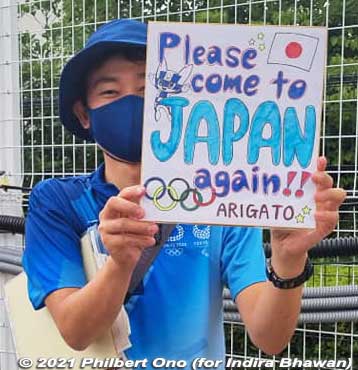
🍀 Total Tokyo 2020 Games (Field Cast) volunteer applicants: 204,680 people in Japan and overseas. About 73,684 of the applicants are foreign nationals, and about 130,996 are Japanese.
Number of Games volunteer applicants selected: About 80,421.
Number of foreign national Games volunteers selected: About 9,651
Number of overseas Games volunteers: 2,300 (later reduced to 500)
Number of Games volunteers activated: 70,970 (51,672 Olympic volunteers and 24,514 Paralympic volunteers, including 5,216 volunteers who worked at both.)
Number of Games volunteers who quit: About 10,000 mostly due to Covid fears.
Age range: Biggest was 20s with 17,354 volunteers, followed by 50s with 16,815, and 40s 11,972. Age 18-19 were 2,112. Three volunteers were in their 90s, and 139 in their 80s.

Gender: 29,677 males, 41,289 females, and 4 neither.
Nationality: 7,092 foreigners (11%) and 63,878 Japanese.
Volunteer Role Assignments (total 70,970):
Guidance (Event Services or EVS): 16,710
Competition Events (SPT, etc.): 17,778
Mobility Support (driving, etc.): 5,393
Personal Support: 10,463
Operational Support: 7,493
Healthcare: 7,221
Technology (TEC, etc.): 1,831
Media (PRS): 3,022
Ceremonies (CER): 1,059
*Note that since EVS volunteers lost their roles due to no spectators, many were reassigned to other roles.
🍀 Tokyo 2020 City (City Cast) volunteers: A total of 30,000 city volunteers were originally recruited. However, only 15,698 remained to work at the Olympics and/or the Paralympics. People dropped out mainly due to COVID-19 fears and the banning of overseas visitors and all spectators.
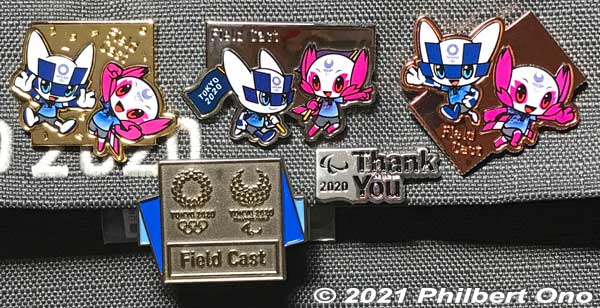
Volunteers received a Field Cast pin every few days of working. After working three days, a bronze pin (extreme right). After 5 days, a silver pin. Then a gold pin after 6 days. But not all volunteers could work as many days as they wanted. “Thank you” pin given on the last day.

September 6, 2021: At a press conference, TOCOG President Hashimoto Seiko states that she is proud that Japan hosted the Olympics and Paralympics despite the pandemic. She expresses her thanks to everyone. She also mentions that she is willing to head the organising committee if Sapporo wins the bid for the 2030 Winter Olympics.
September 6, 2021: The giant Paralympic Agitos logo on a floating barge is removed from Odaiba Marine Park to be scrapped and recycled in Yokohama.
September 7–13, 2021: Tokyo 2020 ticket holders are able to download a PDF version of their unusable tickets. In Japan, those who paid for tickets with a VISA credit card would receive a credit on the card. Those who paid in cash would need to have a bank account to receive the refund during October 1–12, 2021.
September 8, 2021: Paralympic Village in Harumi closes.
Tokyo 2020 Olympics Health Threat Evaluation
🔴 🍀September 8, 2021: TOCOG reports that 323 coronavirus infections (80 foreigners and 243 Japan-based staff) were recorded during the Tokyo Paralympics. Only 13 Para athletes (out of 4,403), 11 volunteers (out of 24,514), 14 TOCOG members, 18 media people, 54 coaches and games officials, and 7 overseas staff at pre-games training camps got infected. The remaining 236 infections were operations staff living in Japan. Only 17 of the infected were Para athletes’ village residents. Only three were hospitalized and soon discharged. No serious cases and no deaths. Covid safety measures effectively prevented Tokyo 2020 from becoming the Covid super spreader imagined by many people.

Coronavirus (COVID-19)
- No COVID-19 clusters within Tokyo 2020 during the Games.
- No evidence of Tokyo 2020 people spreading the virus into the general population.
- No serious COVID-19 cases and no deaths.
- Among the 54,250 Tokyo 2020 people arriving from overseas, only 261 tested positive for COVID-19. They include 157 who tested positive within two weeks after arriving in Japan. Six were hospitalized, no serious cases.
- Of the 1,014,170 tests conducted on all Tokyo 2020 athletes and staff (including Japan-based staff), only 299 positive cases (0.03%) were found. Volunteers and staff were tested (saliva) every seven or four days.
- Among Tokyo 2020 people from overseas who tested positive, no more than two were hospitalized at the same time and no more than 49 stayed at a COVD-19 recovery facility (designated hotel) at the same time.
- During the Tokyo 2020 Olympics, 174 foreigner participants and 373 Japan-based participants tested positive for COVID-19. Only two were hospitalized and soon discharged.
- The COVID-19 positive rate among Games participants from July 1, 2021 to the end of the Olympics was an extremely low 0.02 percent.
Summer Heat
- During the Olympics, 117 athletes and 97 staff suffered from heat illness. Six of the athletes (two with heatstroke) and two staff people required an ambulance, but none were hospitalized.
- During the Paralympics, 36 Paralympic athletes and 30 staff suffered from heat illness. Two of the Paralympic athletes and one staff person required an ambulance, but none were hospitalized.
- No deaths due to the summer heat.
- Medical ice baths were provided at 12 venues (18 events).

Right: For volunteers and staff, cooling cloth and salt tablets provided for free.
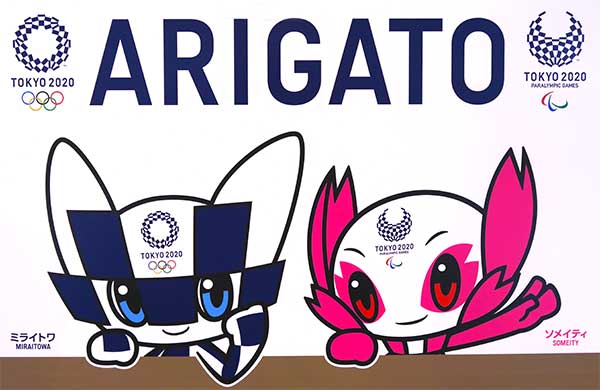
🍀September 2021: Survey of Games volunteers indicates that 80 percent of them want to continue being a sports volunteer.
September 11, 2021: Official Toyota vehicles used to transport athletes and officials during the Games start appearing on used car lots in places like Ehime, Okayama, and Kumamoto Prefectures. Their Tokyo 2020 design trimmings are left intact on the car. About 2,700 Toyota vehicles were used during the Olympics and 1,700 during the Paralympics.
They consisted of about 500 MIRAI cars, 500 Prius PHV cars, 300 Noah Voxy cars, 150 Noah Voxy (welcab) cars, and other vehicles including RAV4, Hilux, Alphard (used to transport Thomas Bach), and Lexus ES. A used Prius PHV sells for around ¥3.5 million. The cars sell well, and buyers are given the paid option to remove the Tokyo 2020 decorative decals.
September 16, 2021: Tokyo 2020 Official Online Shop and most physical shops in Tokyo start their “Tokyo 2020 Appreciation Sale” by offering a 30 percent discount on many official merchandise. https://tokyo2020shop.jp
The ASICS online store also starts offering a 30 percent discount (later increased to 50 percent off) on their Tokyo 2020 merchandise. https://www.asics.com/jp/ja-jp/tokyo2020/
September 2021: Pro soccer, baseball, and the sumo tournament (Kokugikan) in Tokyo continue to be held with spectators.
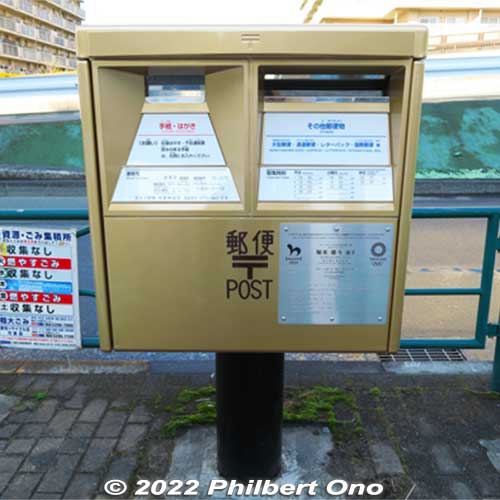
September 24, 2021: The Japanese Cabinet Secretariat and Japan Post start the “Gold Post Project” (ゴールドポストプロジェクト) to honor Tokyo 2020’s Japanese Olympic and Paralympic gold medalists with a golden postal mailbox in their hometowns. The gold medalist could select which mailbox to be repainted gold. The mailbox also has a plaque with the gold medalist’s name and sport. Japan Post’s first golden mailbox is unveiled at Goshomi Post Office (御所見郵便局) in Fujisawa, Kanagawa to honor women’s softball gold medalist Yamada Eri.
As of March 2022, 79 golden mailboxes have been unveiled in Japan. Team Japan won 27 Olympic gold medals and 13 Paralympic gold medals at Tokyo 2020.
September 29, 2021: IOC announces that the Beijing 2022 Winter Olympics will ban overseas spectators. Only spectators from mainland China will be allowed to spectate if they meet the specific requirements for COVID-19 measures. All Beijng 2022 participants must also be vaccinated or else undergo a 21-day quarantine upon arrival in Beijing. Games participants, including athletes, coaches, media, and volunteers, will be in a strict “closed loop” system during the Games, permitted to travel between venues only for training, competitions, or work.
September 30, 2021: About 5,000 TOCOG employees complete their employment contract. TOCOG is left with only 1,500 employees and more employees would eventually leave in the coming months.
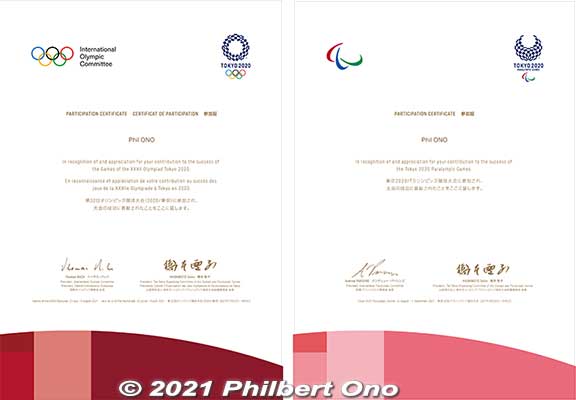
From late September 2021: Participation Certificate emailed to all Tokyo 2020 staff and volunteers.
Photo: Olympic Certificate on the left signed by IOC President Bach and TOCOG President Hashimoto Seiko, and the Paralympic Certificate on the right signed by IPC President Parsons and Hashimoto.
The Olympics Certificate is in English, French, and Japanese. But the Paralympic Certificate is only in English and Japanese.
OCTOBER 2021
Dismantling Tokyo 2020 Venues
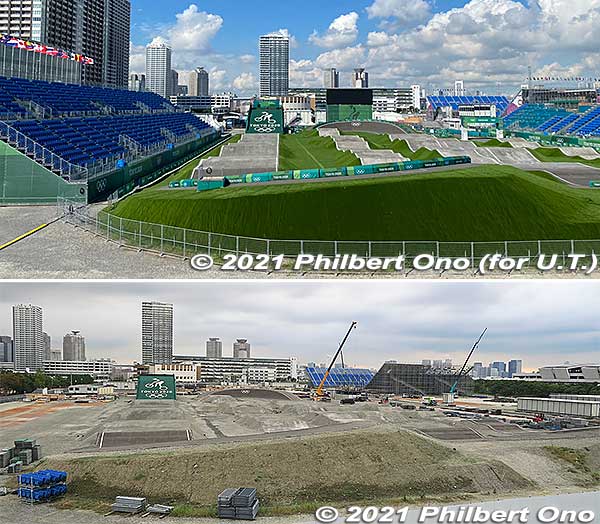
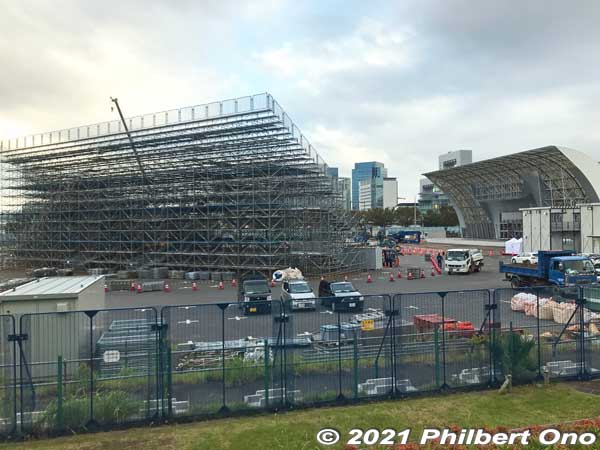
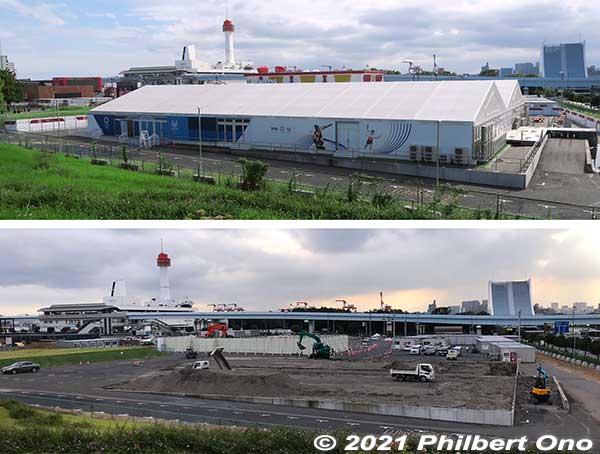
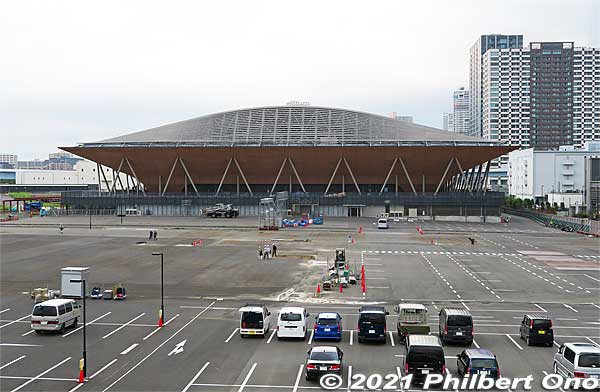
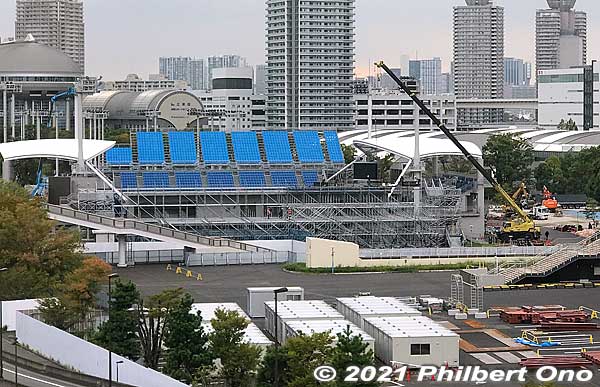
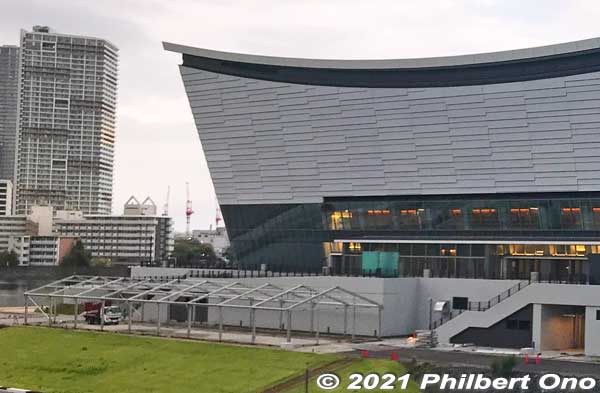
Temporary Tokyo 2020 venues being dismantled. Ten of the 43 Tokyo 2020 venues are temporary. Tokyo Big Sight used as the main media and broadcast center will revert into a trade show facility. Same for Makuhari Messe in Chiba.
A: Aomi Urban Sports Park spectator seats being removed. The entire venue will be dismantled.
B: Before and after shots of the Tokyo 2020 Official Shop megastore in the 2020 Fan Park in Odaiba.
C: Look of the Games has been removed from the Ariake Gymnastics Centre to become a trade show space.
D: Ariake Tennis Park’s Show Court No. 1‘s extra spectator seats being removed.
E: Venue Media Centre at Ariake Arena (permanent venue) is stripped to a skeleton.
October 1, 2021: Tokyo’s state of emergency is lifted, and the daily number of Covid cases in October drops dramatically to well below 100 and later below 50 per day.
October 1, 2021: The Tokyo 2020 Official Online Shop starts a 50 percent discount sale on many items. https://tokyo2020shop.jp
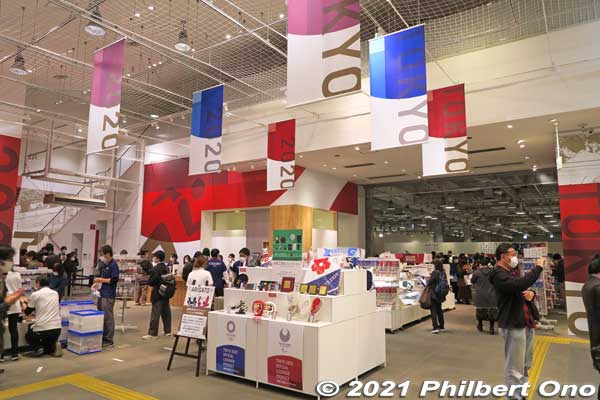
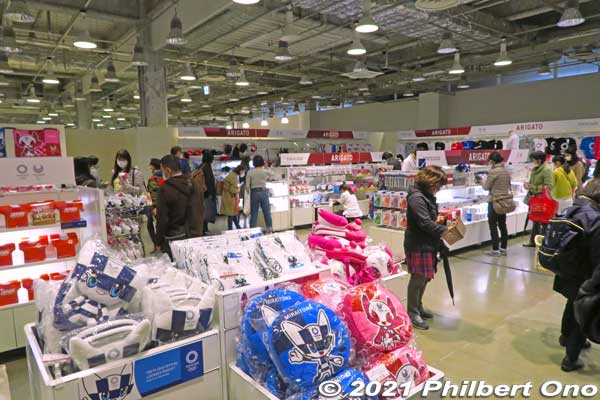
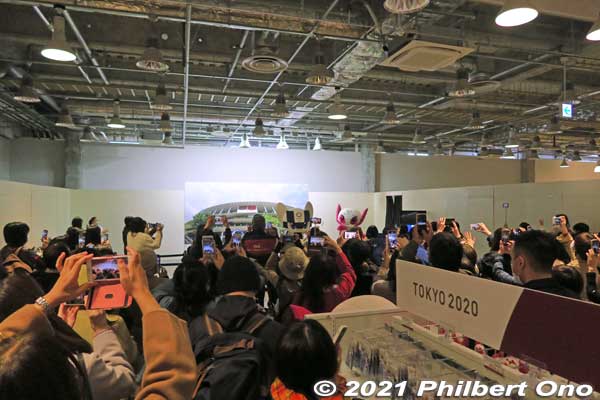
October 16–24, 2021 (photos): Tokyo 2020 Arigato Event (東京2020 ARIGATOイベント) is held at Tokyo Sports Square in Yurakucho. Free event featuring over 1,000 Tokyo 2020 discounted merchandise for sale, exhibits of Tokyo 2020 memorabilia (torch relay torches, cardboard bed, etc.), hands-on activities, and daily appearances of Tokyo 2020 mascots Miratowa and Someity.
October 17, 2021: While wearing a City Cast uniform, Tokyo Governor Koike Yuriko holds a thank you event for City Cast volunteers at TMG. About 340 City volunteers (most wearing the City cast uniform) attend the event highlighted by Governor Koike giving a thank you speech and presenting a letter of appreciation to the volunteers. About 30,000 City volunteers were orignally recruited for Tokyo 2020. However, about 13,000 dropped out due to the postponement, Covid fears, or the banning of spectators.

Tokyo 2020 Archives Exhibition
October 18, 2021: In Tokyo Metropolitan Government No. 1 Building, 2nd floor South side, TMG starts a Tokyo 2020 archives exhibition showing memorabilia including Olympic and Paralympic medals, Victory Bouquet, torch relay torches, and volunteer uniforms. Open every day 9:30 am– 6:15 pm. https://www.2020games.metro.tokyo.lg.jp/special/eng/news/1018_3874.html
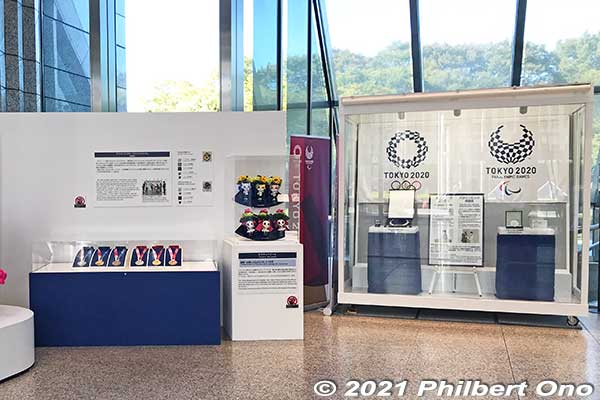
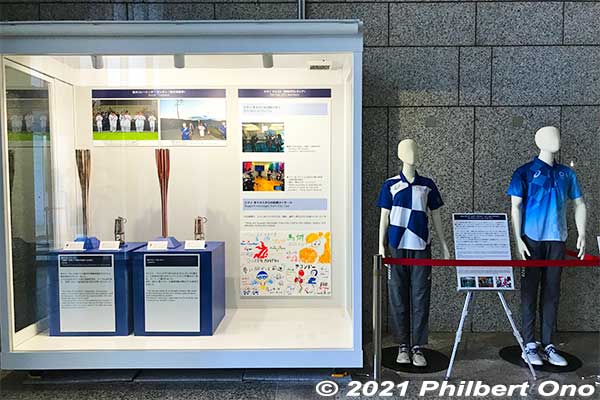
Left: Tokyo 2020 medals and victory bouquets on display.
Right: Volunteer uniforms and torches and lanterns.
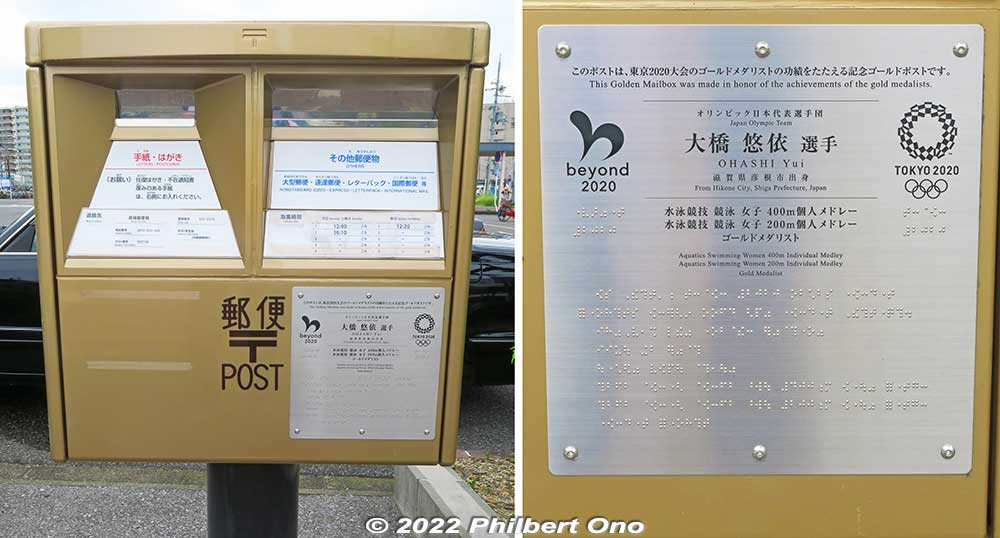
October 19, 2021: As part of the Japanese Cabinet Secretariat and Japan Post’s “Gold Post Project” (ゴールドポストプロジェクト), the third golden Japan Post mailbox is unveiled outside JR Hikone Station (JR Tokaido Line) in Hikone, Shiga Prefecture in honor of Ohashi Yui, Tokyo 2020 Olympic gold medalist in both the Women’s 400m and 200m Individual Medley for swimming. (Normal Japanese mailboxes are vermillion.) Ohashi is from Hikone.
October 21, 2021: TOCOG announces that during the Games, the Tokyo 2020 network systems and other tech infrastructure saw 450 million cases of cyber attacks which were all successfully blocked. This was twice the number of attacks on the London 2012 Games. There were many cases of password spraying attacks trying to hack into systems. NTT was in charge of cybersecurity and was apparently successful in preventing any cyber attacks from disrupting the Games.
In an interview with Sci-Cul journal by NHK, Nakanishi Katsuhiko, who headed TOCOG’s cybersecurity team, mentions that over 6,000 phishing emails were sent repeatedly to TOCOG and sports federations in Japan and overseas in 2019. It was faked as being from TOCOG CEO Muto Toshiro. The emails contained links to phishing websites which were soon blocked by the cybersecurity team. Thanks to thorough training of TOCOG employees, none fell for the phishing trap. Employees had been trained in the past with faked phishing emails to make sure they took precautions.
“Red team” white hat hackers were also hired to hack into Tokyo 2020’s systems to find and fix vulnerabilities. As a result, no hackers succeeded in penetrating the system’s core and taking over the system manager’s account.
Also, before the Games started, over 3,000 domain names similar to Tokyo 2020’s official domain names were discovered. They were all monitored and some of them were used to create fake ticket selling websites, fake official merchandise shops, or fake video streaming sites. The fake websites were taken down when necessary.
October 24, 2021: The Daiba Shop in Aqua City shopping mall in Odaiba and the temporary Yurakucho Shop in Tokyo Sports Square (open since Oct. 16) become the last Tokyo 2020 official shops to close. The Marunouchi Shop closed on September 20 and the Tokyo Skytree Shop closed on September 27, 2021.
October 27, 2021: For the second time this year, Tokyo Governor Koike Yuriko is hospitalized for severe fatigue. She will need one week to rest, TMG announces.
October 31, 2021: Yumenoshima Park Archery Field (training field) reopens for public use.
NOVEMBER 2021
November 2, 2021: The Olympic/Paralympic Village’s Village Plaza starts to be dismantled and the 40,000 pieces of homegrown lumber are to be returned to all 47 prefectures (63 municipaities) where the wood came from. The lumber had been branded with the name of the prefecture where it came from. It will take until Feb. 2022 to return all the wood to be reused in public works such as in schools and benches.

Olympic/Paralympic Village’s Village Plaza being dismantled in late November 2021. Right photo shows lumber branded with “Yamagata City” which donated the wood piece. All the wood (from all 47 prefectures) will be returned to their donors by February 2022.

Ariake Urban Sports Park (ASP) is almost totally gone in late November 2021. Just some piles of broken asphalt and mounds of dirt from the BMX race course. Deconstruction to be completed by mid-December 2021.
November 2, 2021: Tokyo Governor Koike Yuriko is released from the hospital and starts to recuperate at home until the weekend. She is then ordered to telework from home for two weeks.
November 10, 2021: As part of the Japanese Cabinet Secretariat and Japan Post’s “Gold Post Project,” the tenth golden Japan Post mailbox is unveiled outside Higashi-Ojima Station (Toei Shinjuku Line) in Koto Ward, Tokyo in honor of Horigome Yuto, Olympic gold medalist in men’s street skateboarding. Horigome was back in Los Angeles and could not attend the unveiling ceremony. (Normal Japanese mailboxes are vermillion.) Higashi-Ojima Station was closest to Horigome’s home while he lived in Koto.
As of March 2022, 79 golden mailboxes have been unveiled in Japan. Team Japan won 27 Olympic gold medals and 13 Paralympic gold medals at Tokyo 2020.
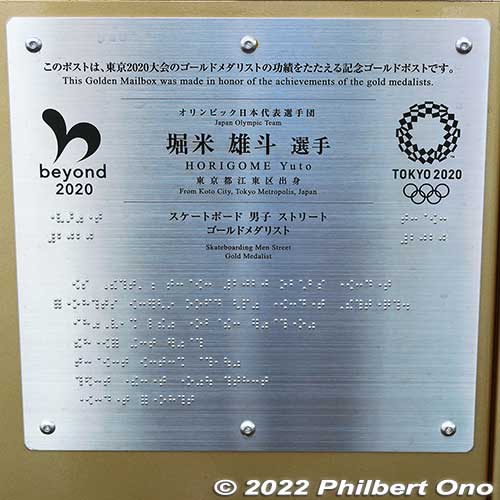
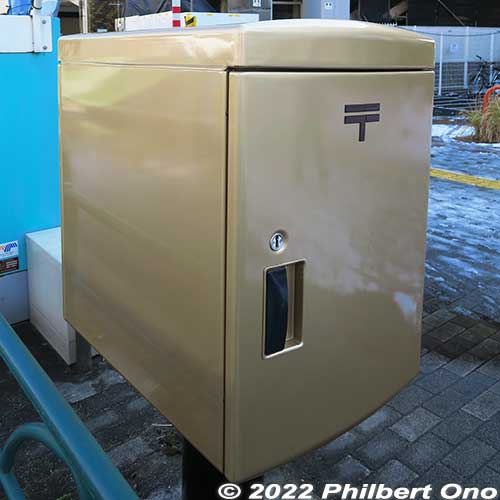
November 12, 2021: Survey by Kyodo News finds that at least 28,000 sets of City Cast uniforms are leftover from Tokyo 2020. Total 48,000 sets of uniforms for City Cast had been purchased by the 11 municipalities which had Tokyo 2020 venues and recruited City Cast volunteers. Tokyo Prefecture had the most leftover including 21,000 pairs of sneakers and 23,000 polo shirts. Each set of City Cast uniforms was purchased for ¥22,000 to ¥40,000 from official sponsor ASICS. The municipalities do not know what to do with the extra uniforms worth over ¥1.7 billion.
November 21, 2021: For first time in four weeks following her second hospitalization this year and recuperation at home, Tokyo Governor Koike Yuriko returns to work at her TMG office.
Tokyo 2020 Final Sale
November 23–30, 2021: Event called “Tokyo 2020 Mascot Greeting” and “Tokyo 2020 Final Sale” is held at Tokyo Sports Square in Yurakucho, Tokyo. Official mascots Miraitowa and Someity visit the site four times a day for a photo op. And the Final Sale is held by the Tokyo 2020 official shop selling merchandise (1,000 different products) at discounted prices (up to 80% off). There is also a display of torch relay torches and sports equipment used by athletes (archives exhibition). Similar to the Arigato Event held in the same building in October. Open 11:30 am to 7:00 pm.
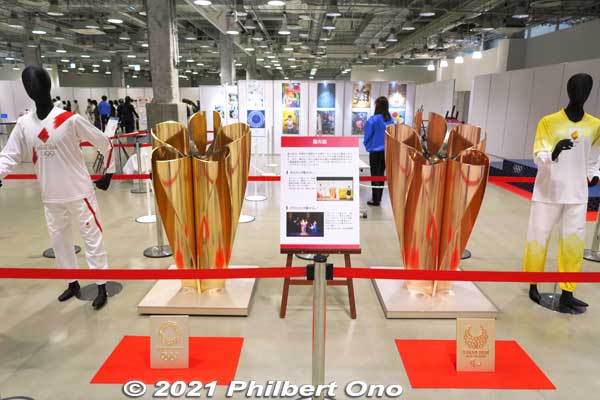

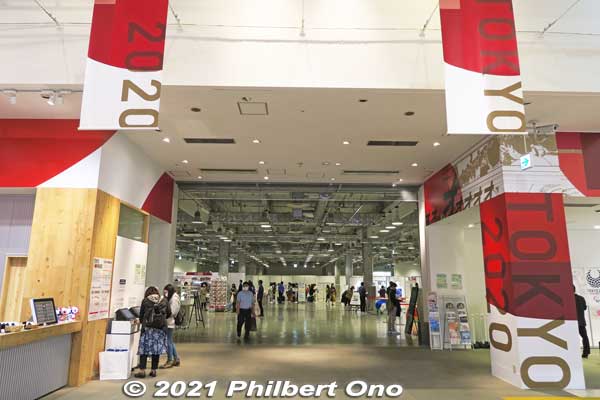
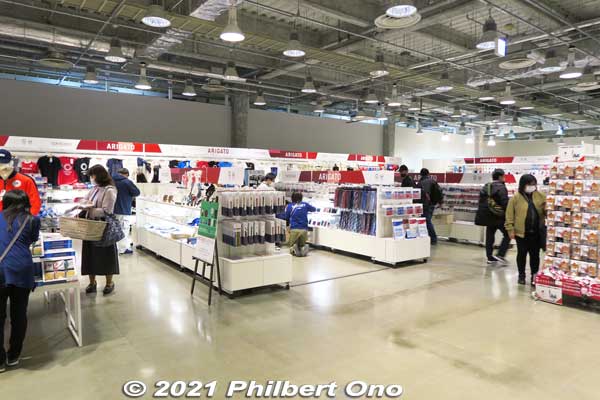

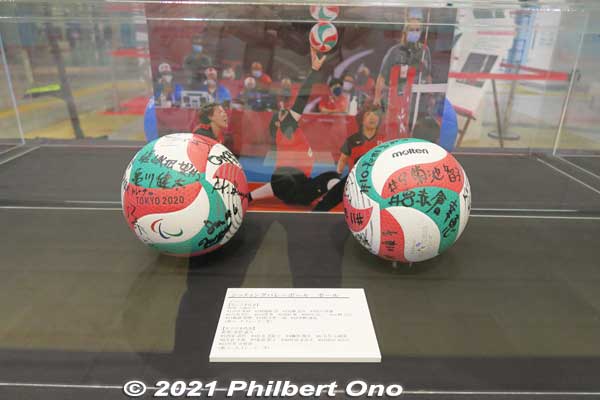
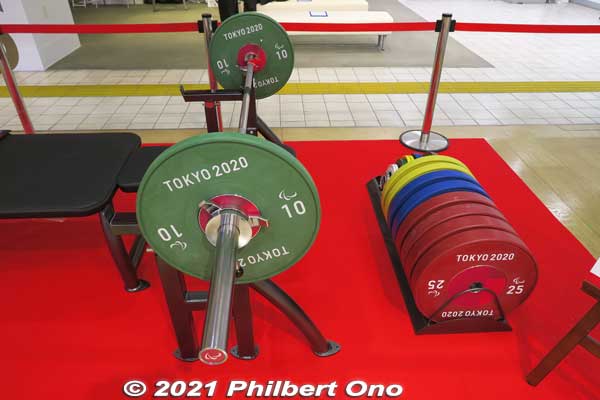

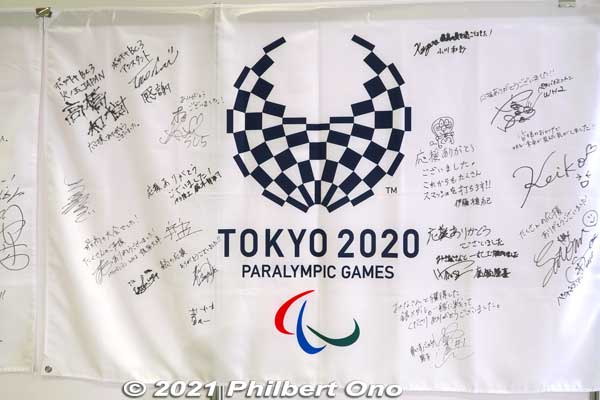
A: Entrance to Tokyo Sports Square for the Final Sale.
B: Entrance hall.
C: Tokyo 2020 merchandise final sale up to 80% off.
D: Exhibit of sports equipment.
E: Sitting volleyball balls signed by Japanese players.
F: Paralympic weightlifting weights.
G: Official mascots Miraitowa and Someity still attract crowds.
H: Tokyo 2020 Paralympic flag signed by Japanese Para athletes.
November 30, 2021: After holding a 30%, 50%, and 80% discount sale on certain items, the Tokyo 2020 Official Online Shop shuts down.
DECEMBER 2021
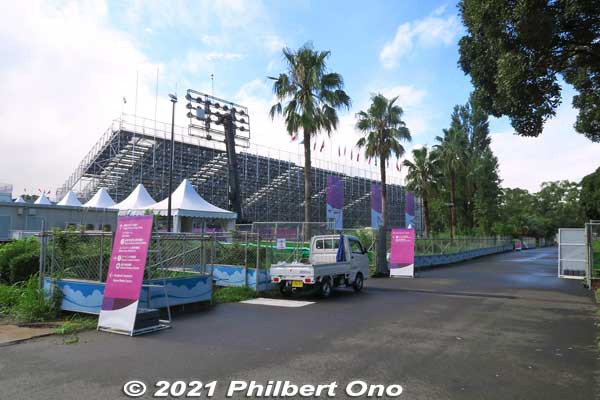
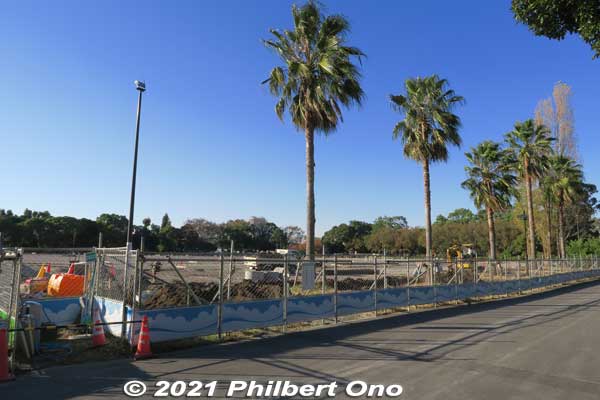
Before and after (early Dec. 2021) photos of Yumenoshima Park Archery Field. Final Field’s East Stand and everything else is no more.
December 7, 2021: At Fukushima Azuma Baseball Stadium (softball and baseball venue), a Tokyo 2020 monument is unveiled to convey the stadium’s Olympic legacy to future generations. Photo here.
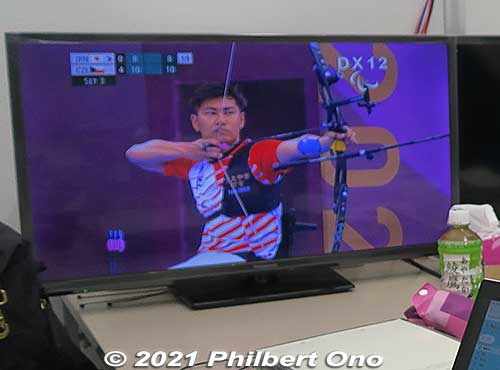
December 8, 2021: IOC releases the results of independent consumer research that found over 3 billion unique viewers worldwide watched Tokyo 2020 on TV or online. Digital platforms alone saw 28 billion video views, a 139 percent increase over Rio 2016. It makes Tokyo 2020 the most watched Games on digital platforms ever. They included digital streaming, websites, apps, and social media. TV coverage also increased by 33 percent over Rio 2016.
The independent consumer research surveyed 32,055 people age 13 to 65 in 17 countries during August 2021. It found 65 percent regarded Tokyo 2020 to be a success, 59 percent thought the Games were the light at the end of the tunnel, and 60 percent thought it would leave a positive legacy for Tokyo and Japan.
IOC President Thomas Bach also declared Tokyo 2020 to be a great success during the board meeting.
The survey of athletes found 82 percent rated the COVID-19 countermeasures at the Olympic Village as “good,” 80 percent rated their overall experience at the Olympic Village as “good” or “very good”, and 79 percent rated the training and competition venues as “good.”
Also, 93 percent of athletes thought it was important “to compete at the biggest multi-sports event on Earth.” https://olympics.com/ioc/news/olympic-games-tokyo-2020-watched-by-more-than-3-billion-people
Tokyo 2020 Audience and Insights Report: https://stillmed.olympics.com/media/Documents/International-Olympic-Committee/IOC-Marketing-And-Broadcasting/Tokyo-2020-External-Communications.pdf
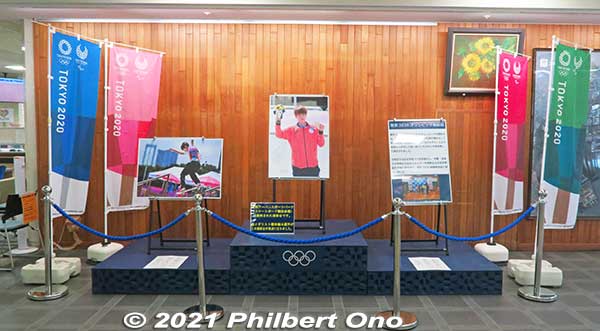
December 9, 2021: At an IOC Executive Board meeting, TOCOG announces that Tokyo 2020’s 98 victory ceremony podiums would be donated to the Japanese medalists’ 300 elementary and junior high schools and hometowns and to municipalities having a Tokyo 2020 venue. The podiums can be disassembled into four pieces. The gold medalist podium has two blocks (upper and lower). The podiums would arrive during Jan. to March 2022. There are 114 Japanese Olympic medalists and 73 Japanese Paralympic medalists.
December 9, 2021: Google announces the Top Ten keyword searches in Japan for 2021 (Jan. 1 to Nov. 22, 2021). “Tokyo 2020 Olympics” is ranked No. 1, followed by “Ohtani Shohei.”
Top Ten Olympic sports searches: 1. Baseball, 2. Soccer (football), 3. Judo, 4. Table tennis, 5. Badminton, 6. Softball, 7. Basketball, 8. Surfing, 9. Tennis, 10. Athletics
Top Ten Paralympic sports searches: 1. Marathon, 2. Wheelchair tennis, 3. Wheelchair basketball, 4. Table tennis, 5. Swimming, 6. Badminton, 7. Judo, 8. Athletics, 9. Wheelchair rugby, 10. Blind soccer/football
Top Ten athlete searches: 1. Ohtani Shohei (MLB baseball), 2. Nakata Sho (pro baseball player suspended for violent acts), 3. Matsuyama Hideki (2021 Masters Tournament golf winner), 4. Ito Mima (table tennis gold medalist), 5. Kinoshita Yusuke (pro baseball player died in Aug.), 6. Mizutani Jun (table tennis gold medalist), 7. Aaron Wolf (judo gold medalist), 8. Ohashi Yui (swimming gold medalist), 9. Abe Hifumi (judo gold medalist), 10. Igarashi Kanoa (surfing silver medalist)
Source: https://trends.google.com/trends/yis/2021/JP/

December 11, 2021: NHK, Japan’s largest TV and news network, announces the results of a Tokyo 2020 public opinion survey it conducted nationwide from Sept. 8 to Oct. 15, 2021. Some 52 percent of 2,217 respondents thought it was good that the Olympics/Paralympics were held this year, 25 percent thought it should have been postponed again (impossible), and only 22 percent thought it should have been canceled.
This proves that Japan has always had widespread public support for Tokyo 2020.
Other survey results (percentage of respondents who gave the respective answer):
Q1: What did you think of the Olympics and Paralympics that were held in Japan for the second time?
A1: Very good: 27%
A2: Good: 52% (A1+A2 = 78%)
A3: Not good at all: 6%
A4: Not so good: 16%
Q2: What did you think about holding the Games postponed by one year?
A5: Good that it was held in 2021: 52%
A6: Should have postponed it again: 25%
A7: Should have been canceled: 22%

Q3: For people who responded A5 above, what was your main reason?
A8: The athletes could be rewarded for their efforts: 59%
A9: Looked forward to the Games held in Japan: 19%
A10: If we waited until COVID-19 subsided, we would never know when the Games can be held: 12%
Q4: For people who responded A6 above (postpone again), what was your main reason?
A11: Coronavirus was still raging in the world: 36%
A12: Coronavirus was still spreading in Japan: 35%
A13: Wanted the athletes to compete without worrying about coronavirus: 14%
Q5: For people who responded A7 above (cancel), what was your main reason?
A14: Coronavirus was still raging in the world: 40%
A15: Coronavirus was still spreading in Japan: 30%
A16: Wanted the money for the Games to be used against coronavirus instead: 15%
Q6: What do you think of most of the Games held without spectators?
A17: It was appropriate: 92%
A18: It was not appropriate: 8%
Q7: Did you think the Games helped with the recovery of the Tohoku Region from the March 11, 2011 disaster?
A19: It really helped with the recovery: 3%
A20: It helped to some degree: 23%
A21: Did not help at all: 23%
A22: It hardly helped: 50%
Q8: Do you think the Tokyo 2020 Paralympics helped to improve public understanding of para-sports?
A23: It helped a lot: 17%
A24: It helped somewhat: 53%
A25: Did not help at all: 6%
A26: Did not help much: 19%
Q9: When watching the Tokyo 2020 Paralympics, what did you think?
A27: Impressed by the athletes taking on the challenge of the sport and the efforts they made to appear in the Paralympics: 72%
A28: Surprised by the sports skills and powerful performance on a level higher than I had expected: 71%
A29: Enjoyed the competition records and results, making it a genuine sport: 64%
A30: It had a different kind of appeal compared to the Olympics: 58%
Q10: To promote understanding of para-sports, what should be done? (Multiple answers permitted.)
A31: Para-sports should be covered more in mass media such as TV and newspapers: 65%
A32: More para-sports events should be held: 34%
A33: Para-sports federations and related organizations should promote their sports more: 30%
Source: https://www3.nhk.or.jp/news/html/20211211/k10013384081000.html
December 13, 2021: Kyoto-based Japan Kanji Aptitude Testing Foundation announces 2021’s Kanji Character of the Year as “Kin” (gold 金) based on the most popular submission (10,422 votes out of 223,773) from the public. The winning kanji character was introduced by the chief priest of the famous Kiyomizu-dera Temple in Kyoto as he wrote the kanji with a large brush. “Kin” was selected mainly in reference to the numerous gold medals won by Japanese athletes at Tokyo 2020. The second most popular kanji (10,304 votes) was “Wa” (rings 輪), also in reference to the Olympics (rings). This year-end tradition started in 1995, and it is actually the fourth time for “Kin” to be selected as Kanji of the Year (今年の漢字). Previously selected in 2000, 2012, and 2016 (all Olympic years).
December 15–20, 2021: In Shinjuku, the huge Tokyo 2020 emblem and mascot billboard posters decorating TMG buildings since May 2016 are removed. The billboards are as large as 8.5 meters wide.
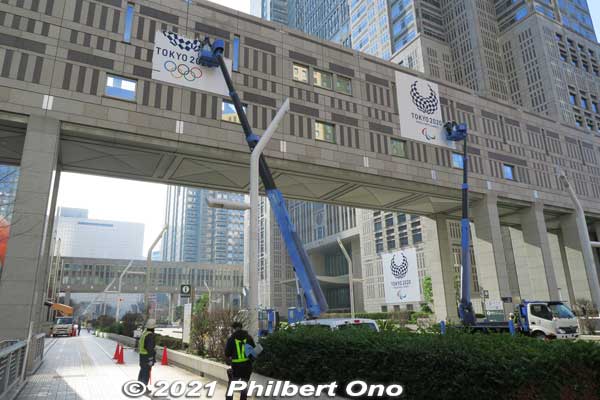

December 21, 2021: A ceremony is held at the Japan Olympic Museum in Tokyo to give a Tokyo 2020 Olympic torch and torch bearer’s uniform to retired sumo wrestler Yokozuna Hakuho (now Magaki Oyakata) who wanted to be a torch bearer, but did not have the chance to do it since he was at the Nagoya sumo tournament in July. TOCOG President Hashimoto Seiko gave him the torch and uniform.
Former TOCOG President Mori Yoshiro was also at the ceremony and revealed that he originally wanted Hakuho to be the final torch bearer to light the cauldron at the top of the steps after receiving the flame from baseball legend Nagashima Shigeo during the Opening Ceremony. Magaki Oyakata was surprised to hear this. (東京五輪聖火リレートーチおよびランナーユニホームお渡し式)
December 22, 2021: At a board meeting, TOCOG announces the estimated cost of Tokyo 2020 to be ¥1.453 trillion. This is about ¥191 billion lower than the budget (¥1.644 trillion) announced in December 2020. TOCOG President Hashimoto Seiko mentions that costs were reduced by simplifying the Games and banning spectators. With no spectators, expenses for COVID-19 safety measures, security staff, and transportation could be reduced.
Meanwhile, the loss in ticket revenue amounts to ¥71.7 billion. This loss is being offset by reduced spending by TOCOG and TMG shelling out ¥62.8 billion. TOCOG will then bear ¥634.3 billion. The total cost of Tokyo 2020 is to be split between TOCOG, TMG, and the Japanese government. TMG is slated to pay ¥624.8 billion (¥77.2 billion less than the previous budget) and the Japanese government ¥193.9 billion (¥27.1 billion less than the previous budget). Thus, no new expenses would be added.
However, the total amount is still about twice the cost estimate (¥734 billion) in 2013 when Tokyo was bidding to host the Games. CEO Muto Toshiro explained that the 2013 estimate basically covered only venue construction costs and did not include operational costs. Therefore, the total cost cannot be compared to the 2013 estimate.
The final total cost of Tokyo 2020 is to be announced in June 2022.
December 24, 2021: TMG announces the results of a late Oct. 2021 online survey asking 500 TMG monitors (observers) about Tokyo 2020. Some 490 replied. To the question about what they thought about holding Tokyo 2020, 28.8 percent answered “Good,” 27.6 percent said “pretty good,” 9 percent “not so good,” 13.9 percent “not good,” and 20.8 percent answered “neither good or bad.”
Among those who said “not so good” or “not good,” 85.7 percent said it was due to the contradiction of holding the Games while telling Tokyo residents and the Japanese people to refrain from going out. And 83.9 percent said it was due to the the spread of COVID-19 and pressure on the medical system. Among those who said “good” or “pretty good,” 76.4 percent cited being impressed by the great performance of athletes.
Some 76.2 percent thought it was appropriate to hold the Games without spectators. Also, 64.2 percent thought the COVID-19 countermeasures were adequate or somewhat adequate.

December 24, 2021: Twenty-nine owners of condomium units in the former Olympic Village (Harumi Flag) file a lawsuit with the Tokyo District Court against the ten real estate developers for the one-year delay to move in. The original move-in date was March 2023. This has been delayed by a year due to the postponement of Tokyo 2020. The real estate developers received an extra year’s worth of lease money from TMG while the owners got no compensation and no explanation from the developers.
The condo owners demand that they can move in as originally scheduled in March 2023 or be paid a total of ¥80 million in compensation. The condo owners cite extra expenses due to paying rent for alternate housing an extra year. It also disrupts their children’s education by going to a different school.
December 27, 2021: Tokyo Bureau of Port and Harbor announces that Harumi Passenger Ship Terminal in the former Olympic Village (now Harumi Flag) that served as the NOC/NPC Services Centre will close on Feb. 20, 2022 and be demolished from July 2022 to April 2023. A new, small- and medium-size passenger ship terminal will be built as a replacement. The new terminal will be smaller and less costly to maintain.
December 31, 2021: The International Fair Play Committee awards the Tokyo 2020 Fair Play Award to women’s park skateboarding finalists Sakura Yosozumi (JPN, gold), Kokona Hiraki (JPN, silver), Sky Brown (GBR, bronze), Poppy Olsen (AUS), Bryce Wettstein (USA), Dora Varella (BRA), and Yndiara Asp (BRA) for consoling reigning world champion and 15-year-old Okamoto Misugu after she fell in her final round and broke into tears. She missed medaling and came in 4th place. Her competitors immediately surrounded her with hugs and lifted her up on their shoulders in one of the most touching moments of Tokyo 2020.
December 31, 2021: In accordance with the agreement with the IOC, licensing for the use of Tokyo 2020’s official mascots and emblems expires. TMG, TOCOG, official shops, official sponsors, etc., had already removed all public PR images of the mascots and official emblems.
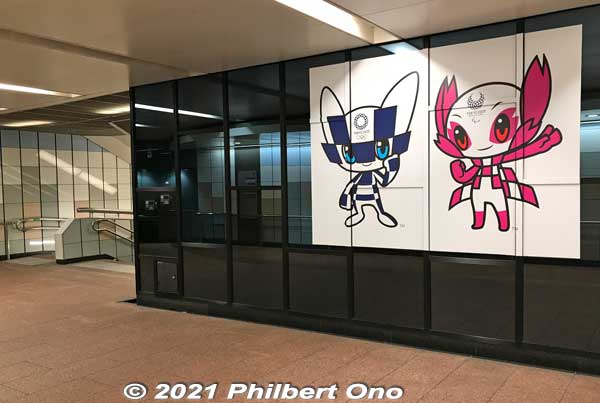
Go to 2022…
Go back to year:
2011 | 2012 | 2013 | 2014 | 2015 | 2016 | 2017 | 2018 | 2019 | 2020 | 2021 | 2022
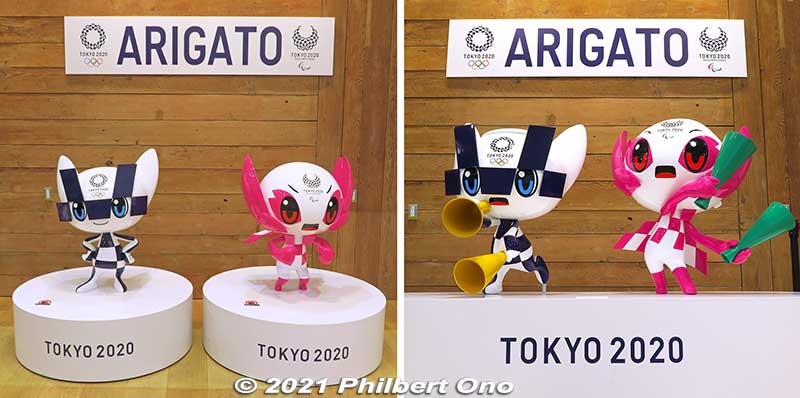
You must do the things you think you cannot do.
– Eleanor Roosevelt
Life is a helluva lot more fun if you say yes rather than no.
– Richard Branson
Sometimes life hits you in the head with a brick. Don’t lose faith.
– Steve Jobs
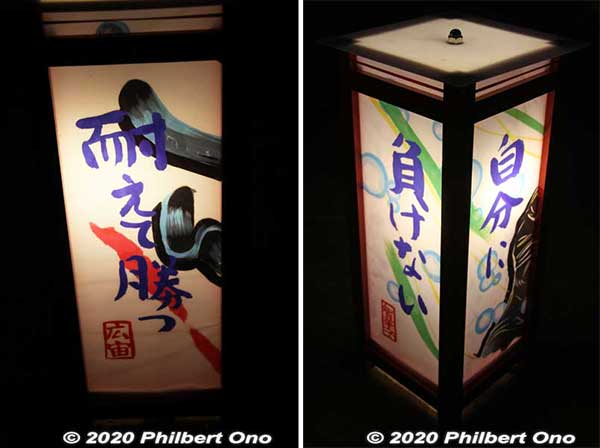
At Katori Shrine in Koto Ward, Tokyo on New Year’s Day 2020.
The shrine worships the “Sports God of Victory” (スポーツ振興の神) rooted in martial archery.
Endure and victory shall come. (耐えて勝つ)
Arai Hirooki (荒井 広宙), Race walker, Rio 2016 Olympic Bronze medalist
Don’t lose to yourself. (自分に負けない)
Ono Chikako (小野 智華子), Paralympic swimmer
Fall down seven times, stand up eight. (七転び八起き)
– Old Japanese proverb
Future Plans
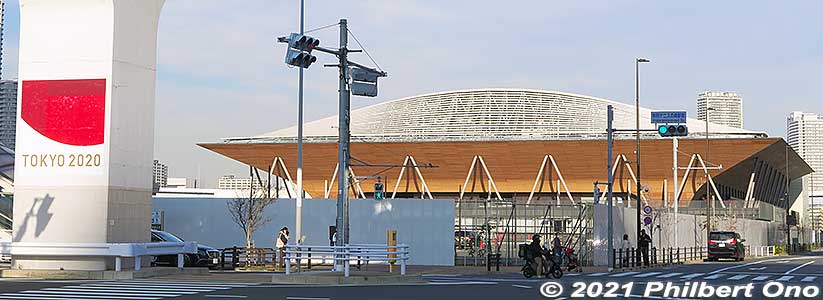
🎯Venues
The waterfront area (Odaiba, Aomi, Ariake, Tatsumi, Yumenoshima) will transform into the Rinkai Sports Zone with legacy areas to enjoy sports. There will be Oi Hockey Stadium, Sea Forest Waterway, Kasai Canoe Slalom Centre, Tokyo Aquatics Centre, Tatsumi International Swimming Center, Yumenoshima Park Archery Field, and Ariake Legacy Area (Ariake Urban Sports Park site, Ariake Arena, and Ariake Tennis Park) for urban sports. Ariake area will see shopping and sports facilities integrated.
Koto Ward/City announced that it will build a skateboarding park within Yumenoshima Park which already has the permanent archery venue.
The strategy is to make sports facilities more accessible, so kids can do sports easily and Japan can nurture more Olympians.
Almost all the new, permanent venues built for Tokyo 2020 are expected to operate in the red. If the coronavirus pandemic lasts too long, it will further inflate the red ink. Five of the six permanent venues built by TMG are expected to operate in the red annually as follows:
・Ariake Arena: ¥356 million/year in the black. The only new permanent venue expected to turn a profit. Besides sporting events, it will host concerts and other diverse events.
・Canoe Slalom Centre: ¥186 million/year in the red.
・Oi Hockey Stadium: ¥92 million/year in the red.
・Olympic Stadium‘s high maintenance cost is estimated to be ¥2.4 billion/year for 50 years including repairs. This is more than twice the old Olympic/National Stadium’s annual maintenance cost (¥1.1 billion).
The stadium uses natural grass turf and the track was made by an Italian company, reputed to be “fast” for runners. The government is also considering to sell naming rights to the stadium, otherwise known as the “National Stadium” (Kokuritsu kyōgijō, same name as the old national stadium). There are not too many sports and concerts which will need this much capacity though.
・Sea Forest Waterway: ¥158 million/year in the red. TMG had planned to reopen this venue by April 2022, however, it continues to be plagued by oyster growth on floating wave dampers along the rowing course. It is costly and troublesome to remove. Officials are studying ways to control the growth which weighs down the wave dampers (消波装置) to become ineffective. It also threatens to prevent the venue from hosting international competitions. The facility also lacks enough lodging and rest spaces for large competitions. Only 140 athletes can currently be accommodated. It is also inconvenient to get to the venue with train stations far away.
・Tatsumi International Swimming Center (Tatsumi Water Polo Centre) will be converted into Tokyo’s first year-round ice rink In 2025. However, it is still expected to operate in the red. A private sector will be hired to operate the facility.
・Tokyo Aquatics Centre: ¥638 million/year in the red. It will take over from Tatsumi International Swimming Center (Tatsumi Water Polo Centre) as Tokyo’s main venue for aquatics competitions.
・Yumenoshima Park Archery Field: ¥11.7 million/year in the red.
Ariake Gymnastics Centre will become a trade show/exhibition space.
Harumi Passenger Ship Terminal in the former Olympic Village (now Harumi Flag) that served as the NOC/NPC Services Centre will close on Feb. 20, 2022 and be demolished from July 2022 to April 2023. A new, small- and medium-size passenger ship terminal will be built as a replacement. The new terminal will be smaller and less costly to maintain.
🎯2030 Winter Olympics Bid
The city of Sapporo is interested in bidding, and TOCOG President Hashimoto Seiko expressed her willingness to head the OCOG if Sapporo wins the bid. The host city will be decided in 2022 or 2023.
On Nov.30, 2021, Sapporo announces that they reduced the cost of the hosting the 2030 Winter Games by 25 percent. It also issues a Games Overview (大会概要) in Japanese: https://www.city.sapporo.jp/sports/olympic/taikaigaiyouann.html
Go to 2022…
Other years:
2011 | 2012 | 2013 | 2014 | 2015 | 2016 | 2017 | 2018 | 2016 | 2017 | 2018 | 2019 | 2020 | 2021 | Olympics | Paralympics | Venues | 2022
Major References:
・Various Japanese news sources: Kyodo, Yomiuri Shimbun, etc.
・https://olympics.com (Many referenced Tokyo 2020 articles already deleted.)
・東京2020 第47回理事会 資料 Report by TOCOG (As of 2021.09.28)
・東京2020大会の振り返りについて (Tokyo 2020 Review by TOCOG) Dec. 22, 2021
・https://www3.nhk.or.jp/news/special/2020news/chronology/
・https://vdata.nikkei.com/newsgraphics/tokyo2020-visual-report/
・Facebook Group: 2020 Tokyo Olympics/Paralympics Volunteer Info
